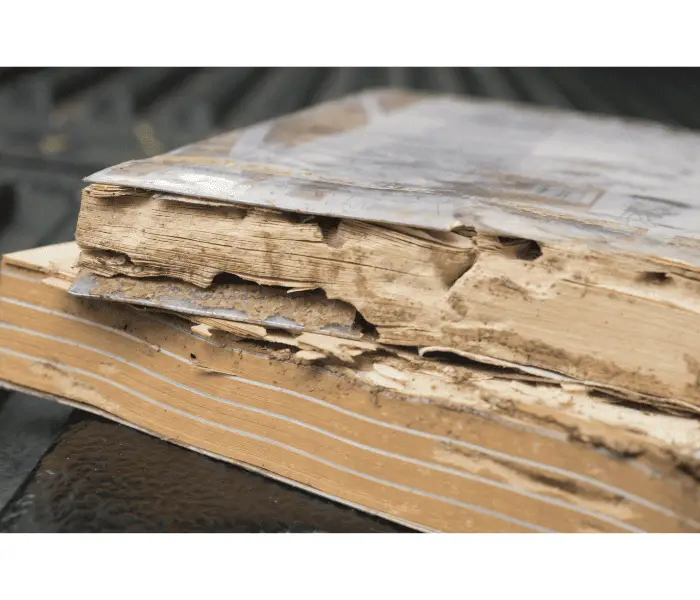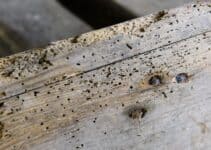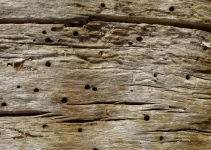Woodworm is a catch-all word for the wood-boring beetle species. These larvae feed on wood shortly after hatching from their eggs and bore tunnels through the material as they do so. Only after becoming adults do they emerge from the timber, leaving distinctive holes in the surface of the wood.
But do woodworm eat paper? Book-eating insects are extremely uncommon. Although some beetles and some moths will attack leather and cloth-bound books, neither will truly consume the paper, only the binding.
Although woodworms will consume paper if it touches wood, they prefer to gnaw through your furniture.
Why Don’t Woodworm Eat Paper?
Three types of beetles are usually referred to as deathwatch (Anobiidae family), powder post, and false powderpost beetles.
These insects are the principal culprits for destroying antique furniture, doors, picture frames, chairs, other building items and structural timber (Bostrichidae family).

Do Woodworm Eat Cardboard?
Woodworm do not typically eat cardboard because it does not contain the same nutrients and properties as wood. Cardboard is made from processed paper fibers, which lack the cellulose and lignin that woodworms require for nutrition.
Cellulose and lignin are complex carbohydrates found in wood that provide structural support and energy for woodworms. Cardboard, on the other hand, is made from recycled paper and often contains other materials such as glue, ink, and coatings that are unappetising and indigestible to woodworms.
While cardboard is not a suitable food source for woodworms, it can still attract them if it is stored in a damp environment. This is because woodworms prefer moist conditions to lay their eggs and develop into larvae.
Therefore, it is important to store cardboard and other materials in a dry, well-ventilated area to prevent woodworm infestations.

Does Woodworm Eat Books?
Woodworms do not eat books. They are the larvae of wood-boring beetles and for the same reason they do not eat cardboard – they feed on wood, not paper. While they can cause damage to wooden bookshelves and other wooden furniture, they do not pose a direct threat to books themselves.
However, other pests such as booklice, silverfish, and termites can damage books. Booklice and silverfish feed on the glues and pastes used in bookbinding, while termites can consume paper if they are unable to find other sources of cellulose.

Furniture Bug
The furniture bug infests only hardwood and conifer sapwood. Compared to furniture, it harms joinery and structural timbers more. The females lay the eggs inside the last exit holes or in surface fissures in the wood.
In just a matter of weeks, the eggs develop into wood-boring larvae.
Over three to four years, the larvae mature while consuming the wood. After pupating close to the wood’s surface, the adults leave a 1-1.5 mm-diameter exit hole.
By having wood dust surrounding holes, an infection is active.
Due to the lengthy duration of the larval stage, an active infestation may go unnoticed for years. The type of wood, temperature, and humidity affect how long an animal takes to mature into an adult.
So, they are interested in something other than your books but only want your wooden items.
False Powderpost Beetles
The fake powderpost beetles attack several softwoods and hardwoods. The insects are frequently present in tropical wood and bamboo traded internationally.
The beetles frequently infest hardwood objects such as flooring, paneling, furniture, and other items.
Instead of depositing eggs on the wood’s surface, females bore a ‘gallery’ into pores or fractures. This subgroup of wood borers is distinguished from others by the coarse, granular frass that its larvae pack into its burrows.
Even these do not need to feed on paper in any stage of their development.
Powderpost Beetles
Powderpost beetles preferentially feed on the sapwood of oak, ash, walnut, mahogany, and bamboo because of the high starch content and wide pores in the wood that allow the beetles to deposit their eggs.
Frequently, insects are present in imported tropical hardwoods. Softwood, which comes from conifers and has fewer nutrients, is never infected, despite having smaller pores than hardwoods like birch and maple.
Beetles preferentially feed on wood with humidity levels as low as 8%.
Powderpost beetles are uncommon in ancient wood because the starch content of the wood decreases with age. They are more prevalent in newly constructed homes and contemporary hardwood products such as paneling, flooring, plywood, window and door frames, and furniture.
Powderpost beetles rarely infect structural timbers since softwood is typically used for construction.
Even though the beetles can’t infest finished wood once it’s been processed, they can still emerge from wood that was already infected before the finish was applied. So, it is clear that even this species is not interested in paper.



